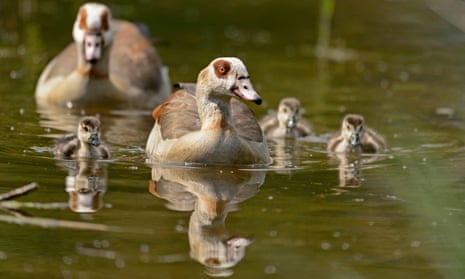We pushed off from the jetty and rowed towards the quieter south-east side of the lake, the chatter of picnickers on the heath and the rusty creak of the roundabout in the children’s playground fading into the distance. The moulted feathers and downy seed heads that strew the silt-laden water looked like the aftermath of a pillow fight. We drifted, savouring the languid warmth of the late afternoon as we watched sand and house martins swooping down to skim the surface for insects. Above them, swifts scythed through the air and a heron flapped past on flaggy wings.
Nearing the shore we dug our oars edgeways into the mud, punting over the shallows. Jewel-bright common blue damselflies and broad-bodied chaser dragonflies danced across a floating carpet of amphibious bistort (Persicaria amphibia), pausing to perch on the short, blush-pink flower spikes. As we sculled into deeper water, we were surrounded by a flotilla of juvenile mallards. They trailed in our wake as we set out to circumnavigate the willow-covered islet in the centre of the lake.
My attention was drawn to the far bank, where two mature Egyptian geese flanked a trio of well-grown goslings. Native to central and southern Africa, the species Alopochen aegyptiacus has been present in Britain since the late 17th century. With amber eyes, chestnut-coloured chest and eye patches, dusky apricot breast and rufous-brown upper plumage, they made an attractive addition to ornamental wildfowl collections. As a result of accidental releases, there is now a self-sustaining feral population, and these showy birds have been resident on the Heath Pond for many years.
As the gangly youngsters pecked at the pitted sand, they were charged by a territorial coot. Panicking, they ran splay-legged towards the water. Rushing to the defence of their offspring, the adult geese confronted the attacker, simultaneously rearing up in a spread-winged threat-display. There are few differentiating features between the sexes, though females are slightly smaller. From a distance the pair were visually indistinguishable, but it was easy for us to identify which was which from their agitated vocalisations – the female’s strident, trumpeting honk duetting with her mate’s hoarse hissing.

Comments (…)
Sign in or create your Guardian account to join the discussion